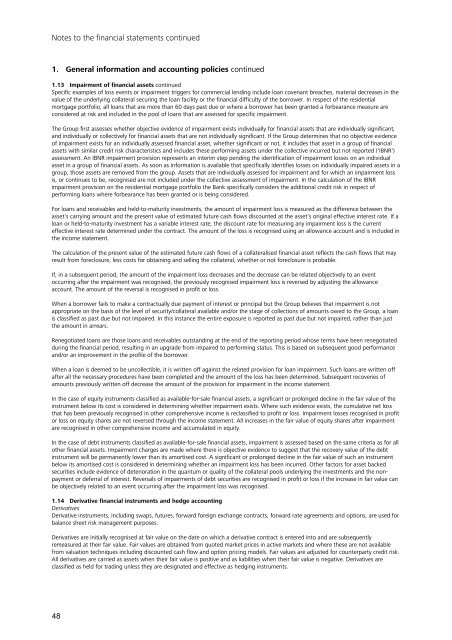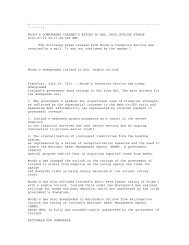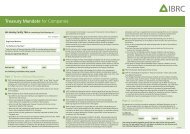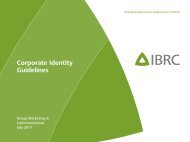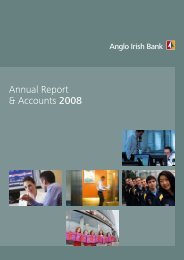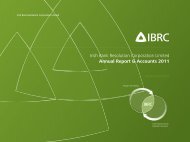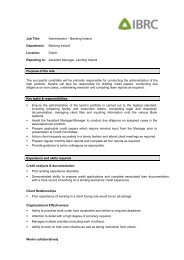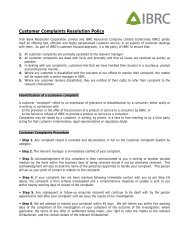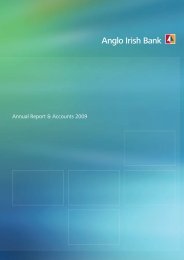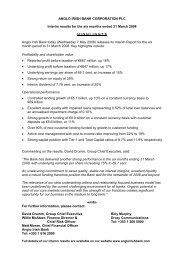IBRC annual report for 2011 - Irish Bank Resolution Corporation ...
IBRC annual report for 2011 - Irish Bank Resolution Corporation ...
IBRC annual report for 2011 - Irish Bank Resolution Corporation ...
Create successful ePaper yourself
Turn your PDF publications into a flip-book with our unique Google optimized e-Paper software.
Notes to the financial statements continued1. General in<strong>for</strong>mation and accounting policies continued1.13 Impairment of financial assets continuedSpecific examples of loss events or impairment triggers <strong>for</strong> commercial lending include loan covenant breaches, material decreases in thevalue of the underlying collateral securing the loan facility or the financial difficulty of the borrower. In respect of the residentialmortgage portfolio, all loans that are more than 60 days past due or where a borrower has been granted a <strong>for</strong>bearance measure areconsidered at risk and included in the pool of loans that are assessed <strong>for</strong> specific impairment.The Group first assesses whether objective evidence of impairment exists individually <strong>for</strong> financial assets that are individually significant,and individually or collectively <strong>for</strong> financial assets that are not individually significant. If the Group determines that no objective evidenceof impairment exists <strong>for</strong> an individually assessed financial asset, whether significant or not, it includes that asset in a group of financialassets with similar credit risk characteristics and includes these per<strong>for</strong>ming assets under the collective incurred but not <strong>report</strong>ed ('IBNR')assessment. An IBNR impairment provision represents an interim step pending the identification of impairment losses on an individualasset in a group of financial assets. As soon as in<strong>for</strong>mation is available that specifically identifies losses on individually impaired assets in agroup, those assets are removed from the group. Assets that are individually assessed <strong>for</strong> impairment and <strong>for</strong> which an impairment lossis, or continues to be, recognised are not included under the collective assessment of impairment. In the calculation of the IBNRimpairment provision on the residential mortgage portfolio the <strong>Bank</strong> specifically considers the additional credit risk in respect ofper<strong>for</strong>ming loans where <strong>for</strong>bearance has been granted or is being considered.For loans and receivables and held-to-maturity investments, the amount of impairment loss is measured as the difference between theasset's carrying amount and the present value of estimated future cash flows discounted at the asset's original effective interest rate. If aloan or held-to-maturity investment has a variable interest rate, the discount rate <strong>for</strong> measuring any impairment loss is the currenteffective interest rate determined under the contract. The amount of the loss is recognised using an allowance account and is included inthe income statement.The calculation of the present value of the estimated future cash flows of a collateralised financial asset reflects the cash flows that mayresult from <strong>for</strong>eclosure, less costs <strong>for</strong> obtaining and selling the collateral, whether or not <strong>for</strong>eclosure is probable.If, in a subsequent period, the amount of the impairment loss decreases and the decrease can be related objectively to an eventoccurring after the impairment was recognised, the previously recognised impairment loss is reversed by adjusting the allowanceaccount. The amount of the reversal is recognised in profit or loss.When a borrower fails to make a contractually due payment of interest or principal but the Group believes that impairment is notappropriate on the basis of the level of security/collateral available and/or the stage of collections of amounts owed to the Group, a loanis classified as past due but not impaired. In this instance the entire exposure is <strong>report</strong>ed as past due but not impaired, rather than justthe amount in arrears.Renegotiated loans are those loans and receivables outstanding at the end of the <strong>report</strong>ing period whose terms have been renegotiatedduring the financial period, resulting in an upgrade from impaired to per<strong>for</strong>ming status. This is based on subsequent good per<strong>for</strong>manceand/or an improvement in the profile of the borrower.When a loan is deemed to be uncollectible, it is written off against the related provision <strong>for</strong> loan impairment. Such loans are written offafter all the necessary procedures have been completed and the amount of the loss has been determined. Subsequent recoveries ofamounts previously written off decrease the amount of the provision <strong>for</strong> impairment in the income statement.In the case of equity instruments classified as available-<strong>for</strong>-sale financial assets, a significant or prolonged decline in the fair value of theinstrument below its cost is considered in determining whether impairment exists. Where such evidence exists, the cumulative net lossthat has been previously recognised in other comprehensive income is reclassified to profit or loss. Impairment losses recognised in profitor loss on equity shares are not reversed through the income statement. All increases in the fair value of equity shares after impairmentare recognised in other comprehensive income and accumulated in equity.In the case of debt instruments classified as available-<strong>for</strong>-sale financial assets, impairment is assessed based on the same criteria as <strong>for</strong> allother financial assets. Impairment charges are made where there is objective evidence to suggest that the recovery value of the debtinstrument will be permanently lower than its amortised cost. A significant or prolonged decline in the fair value of such an instrumentbelow its amortised cost is considered in determining whether an impairment loss has been incurred. Other factors <strong>for</strong> asset backedsecurities include evidence of deterioration in the quantum or quality of the collateral pools underlying the investments and the nonpaymentor deferral of interest. Reversals of impairments of debt securities are recognised in profit or loss if the increase in fair value canbe objectively related to an event occurring after the impairment loss was recognised.1.14 Derivative financial instruments and hedge accountingDerivativesDerivative instruments, including swaps, futures, <strong>for</strong>ward <strong>for</strong>eign exchange contracts, <strong>for</strong>ward rate agreements and options, are used <strong>for</strong>balance sheet risk management purposes.Derivatives are initially recognised at fair value on the date on which a derivative contract is entered into and are subsequentlyremeasured at their fair value. Fair values are obtained from quoted market prices in active markets and where these are not availablefrom valuation techniques including discounted cash flow and option pricing models. Fair values are adjusted <strong>for</strong> counterparty credit risk.All derivatives are carried as assets when their fair value is positive and as liabilities when their fair value is negative. Derivatives areclassified as held <strong>for</strong> trading unless they are designated and effective as hedging instruments.48


